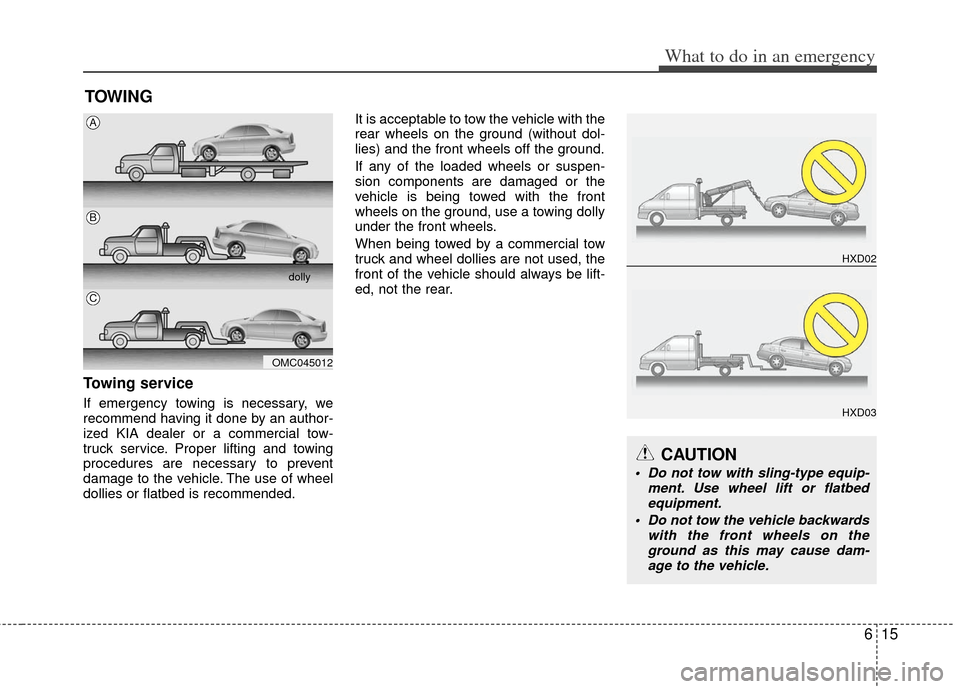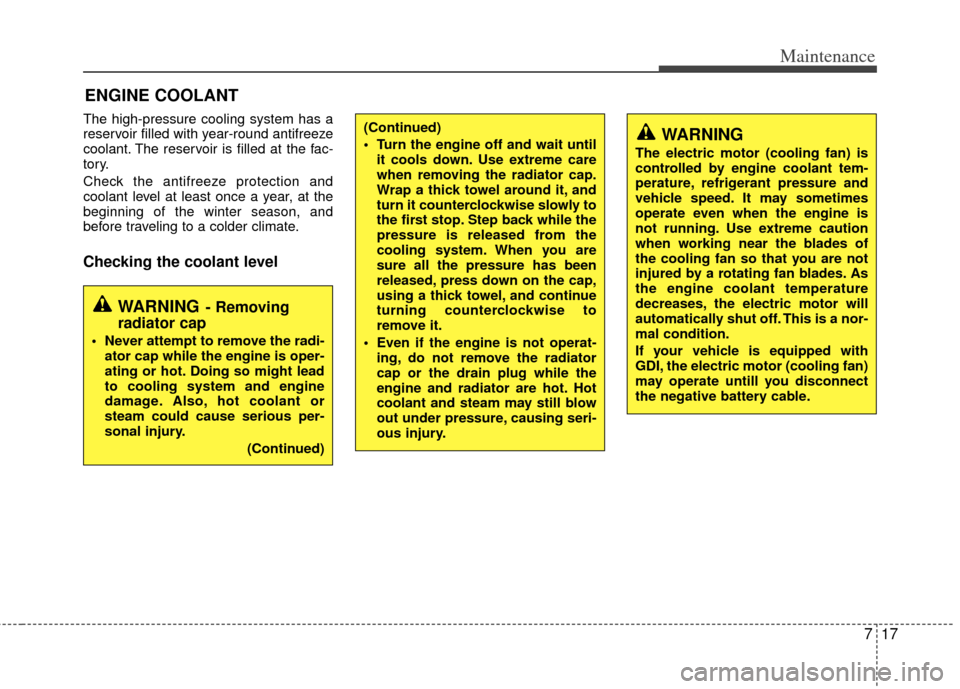tow KIA Optima 2011 3.G Owner's Guide
[x] Cancel search | Manufacturer: KIA, Model Year: 2011, Model line: Optima, Model: KIA Optima 2011 3.GPages: 385, PDF Size: 8.85 MB
Page 300 of 385

What to do in an emergency
14
6
Do not take this vehicle through an
automatic car wash while the com-
pact spare tire is installed.
The compact spare tire should not be installed on the front axle if the
vehicle must be driven in snow or
on ice.
Do not use the compact spare tire on any other vehicle because this
tire has been designed especially
for your vehicle.
The compact spare tire’s tread life is shorter than a regular tire.
Inspect your compact spare tire
regularly and replace worn com-
pact spare tires with the same size
and design, mounted on the same
wheel. The compact spare tire should not
be used on any other wheels, nor
should standard tires, snow tires,
wheel covers or trim rings be used
with the compact spare wheel. If
such use is attempted, damage to
these items or other car compo-
nents may occur.
Do not use more than one compact spare tire at a time.
Do not tow a trailer while the com- pact spare tire is installed.
Page 301 of 385

615
What to do in an emergency
TOWING
Towing service
If emergency towing is necessary, we
recommend having it done by an author-
ized KIA dealer or a commercial tow-
truck service. Proper lifting and towing
procedures are necessary to prevent
damage to the vehicle. The use of wheel
dollies or flatbed is recommended.It is acceptable to tow the vehicle with the
rear wheels on the ground (without dol-
lies) and the front wheels off the ground.
If any of the loaded wheels or suspen-
sion components are damaged or the
vehicle is being towed with the front
wheels on the ground, use a towing dolly
under the front wheels.
When being towed by a commercial tow
truck and wheel dollies are not used, the
front of the vehicle should always be lift-
ed, not the rear.
CAUTION
Do not tow with sling-type equip-
ment. Use wheel lift or flatbedequipment.
Do not tow the vehicle backwards with the front wheels on theground as this may cause dam-age to the vehicle.
HXD02
HXD03
OMC045012 dolly
A
B
C
Page 302 of 385

What to do in an emergency
16
6
When towing your vehicle in an emer-
gency without wheel dollies :
1. Set the ignition switch in the ACC posi-
tion.
2. Place the shift lever in N (Neutral).
3. Release the parking brake.
CAUTION
Failure to place the transaxle shift lever in N (Neutral) may cause inter-nal damage to the transaxle.
Page 313 of 385

711
Maintenance
MAINTENANCE UNDER SEVERE USAGE CONDITIONS (T-GDI ENGINE)
The following items must be serviced more frequently on cars mainly used under severe driving conditions.
Refer to the chart below for the appropriate maintenance intervals.
R : Replace
SEVERE DRIVING CONDITIONS
A - Repeatedly driving shorts distanse of less than 8 km (5 miles) innormal temperature or less than 16 km (10 miles) in freezing tem-
perature
B - Extensive engine idling or low speed driving for long distances
C - Driving on rough, dusty, muddy, unpaved, graveled or salt-spread roads
D - Driving in areas using salt or other corrosive materials or in very cold weather E - Driving in sandy areas
F - Driving in heavy traffic area over 32°C (90°F)
G - Driving on uphill, downhill, or mountain road
H - Towing a Trailer, or using a camper, or roof rack
I - Driving as a patrol car, taxi, other commercial use or vehicle towing
J - Frequently driving in stop-and-go conditions
MAINTENANCE ITEMMaintenance
operationMaintenance intervalsDriving condition
Engine oil and engine oil filterRReplace every 5,000 km or 3 monthsA, B, C, D, E, F,
G, H, I, J
Spark plugsRReplace more frequently
depending on the conditionB, H
Page 319 of 385

717
Maintenance
ENGINE COOLANT
The high-pressure cooling system has a
reservoir filled with year-round antifreeze
coolant. The reservoir is filled at the fac-
tory.
Check the antifreeze protection and
coolant level at least once a year, at the
beginning of the winter season, and
before traveling to a colder climate.
Checking the coolant level
WARNING- Removing
radiator cap
Never attempt to remove the radi-
ator cap while the engine is oper-
ating or hot. Doing so might lead
to cooling system and engine
damage. Also, hot coolant or
steam could cause serious per-
sonal injury.
(Continued)
(Continued)
Turn the engine off and wait untilit cools down. Use extreme care
when removing the radiator cap.
Wrap a thick towel around it, and
turn it counterclockwise slowly to
the first stop. Step back while the
pressure is released from the
cooling system. When you are
sure all the pressure has been
released, press down on the cap,
using a thick towel, and continue
turning counterclockwise to
remove it.
Even if the engine is not operat- ing, do not remove the radiator
cap or the drain plug while the
engine and radiator are hot. Hot
coolant and steam may still blow
out under pressure, causing seri-
ous injury.WARNING
The electric motor (cooling fan) is
controlled by engine coolant tem-
perature, refrigerant pressure and
vehicle speed. It may sometimes
operate even when the engine is
not running. Use extreme caution
when working near the blades of
the cooling fan so that you are not
injured by a rotating fan blades. As
the engine coolant temperature
decreases, the electric motor will
automatically shut off. This is a nor-
mal condition.
If your vehicle is equipped with
GDI, the electric motor (cooling fan)
may operate untill you disconnect
the negative battery cable.
Page 385 of 385

I9
Index
Tires and wheels ··················\
··················\
··················\
········8-3
Towing ··················\
··················\
··················\
··················\
···6-15
Trailer towing··················\
··················\
··················\
···········5-55
TransaxleAutomatic transaxle ··················\
··················\
·················5-15\
Manual transaxle ··················\
··················\
··················\
···5-12
Trip computer ··················\
··················\
··················\
··········4-51
Trunk ··················\
··················\
··················\
··················\
······4-18
Vehicle break-in process ··················\
··················\
··············1-4
Vehicle certification label ··················\
··················\
············8-6
Vehicle identification number (VIN) ··················\
·············8-6
Vehicle load limit ··················\
··················\
··················\
·····5-50 Certification label ··················\
··················\
··················\
··5-53
Vehicle option ··················\
··················\
··················\
··········4-57
Vehicle stability management ··················\
··················\
····5-33
Vehicle weight ··················\
··················\
··················\
·········5-55 Base curb weight ··················\
··················\
··················\
···5-55
Cargo weight ··················\
··················\
··················\
·········5-55
GAW (Gross axle weight) ··················\
··················\
·······5-55
GAWR (Gross axle weight rating) ··················\
············5-55
GVW (Gross vehicle weight) ··················\
··················\
··5-55
GVWR (Gross vehicle weight rating) ··················\
·······5-55 Warnings and indicators ··················\
··················\
············4-58
Washer fluid ··················\
··················\
··················\
·············7-21
Weight ··················\
··················\
··················\
··················\
····5-55
Base curb weight ··················\
··················\
··················\
···5-55
Cargo weight ··················\
··················\
··················\
·········5-55
GAW (Gross axle weight) ··················\
··················\
·······5-55
GAWR (Gross axle weight rating) ··················\
············5-55
GVW (Gross vehicle weight) ··················\
··················\
··5-55
GVWR (Gross vehicle weight rating) ··················\
·······5-55
Welcome system ··················\
··················\
··················\
······4-79
Wheel alignment and tire balance ··················\
···············7-38
Wheel replacement ··················\
··················\
··················\
··7-39
Windows ··················\
··················\
··················\
··················\
4-21 Auto down window ··················\
··················\
·················4-22\
Auto up/down window ··················\
··················\
············4-23
Power window lock button ··················\
··················\
······4-24
Windshield defrosting and defogging··················\
········4-109 Defogging logic ··················\
··················\
··················\
···4-111
Auto defogging system··················\
··················\
··········4-112
Winter driving ··················\
··················\
··················\
··········5-47 Snow tires ··················\
··················\
··················\
··············5-47
Wiper blades ··················\
··················\
··················\
············7-27
Wipers and washers ··················\
··················\
··················\
·4-85
V
W